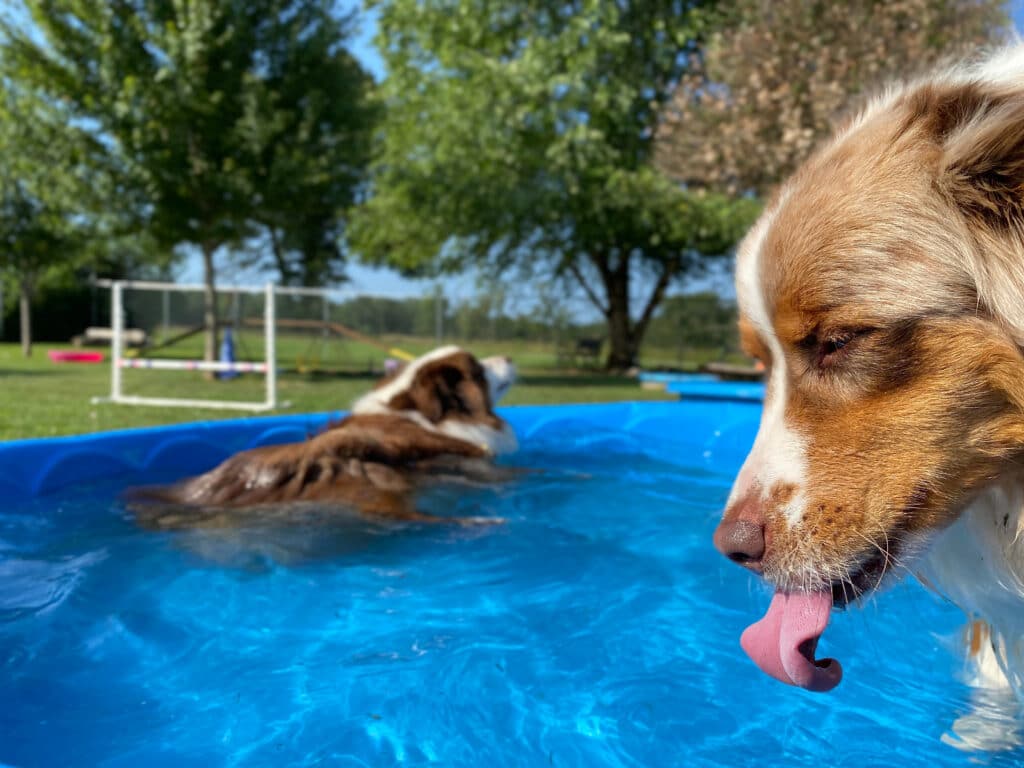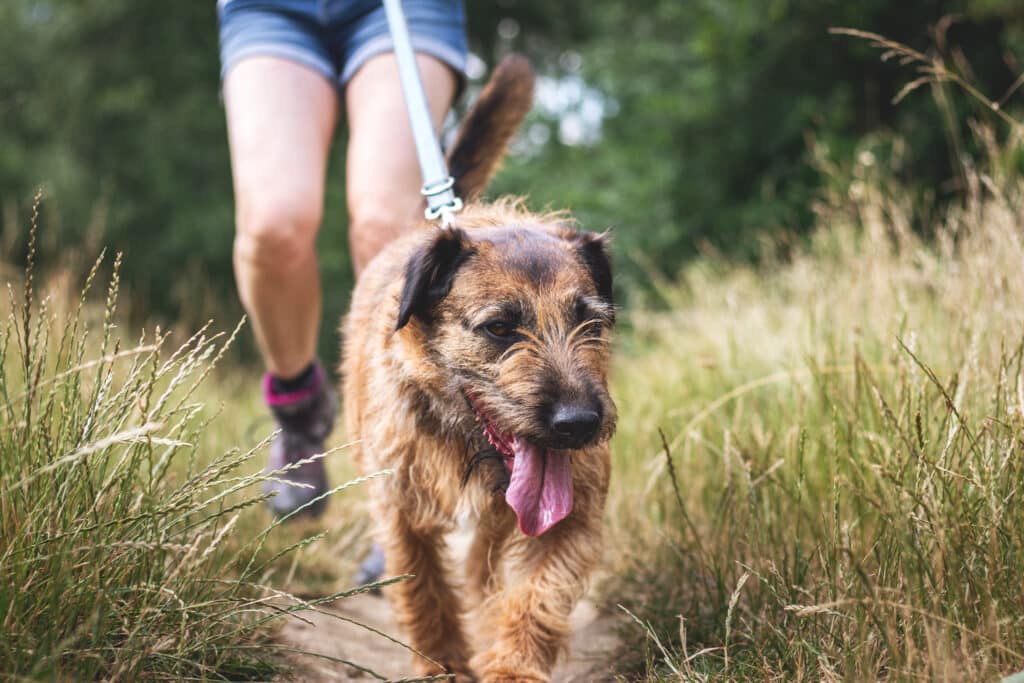How to Keep Dogs Cool Outside in the Colorado Summers
While Colorado might be known for its snowy peaks, summers here can get surprisingly hot, especially at higher altitudes. As a high alpine desert, Colorado experiences intense sunshine and dry heat that can quickly overheat your dog. As professional dog trainers in Lafayette, CO (near Denver and Boulder areas) – we know a thing or two. We’ve put together this blog post here to help! So, whether you’ve just brought home a new rescue dog, or have had your pup for years – here are some essential tips on how to keep dogs cool outside all summer long, along with other safety precautions to ensure your furry friend enjoys the season safely.
Importance of Knowing How to Keep Dogs Cool Outside
Dogs don’t sweat the way humans do, making them highly susceptible to overheating. Heatstroke is a serious medical emergency that can be fatal if not treated promptly. By following these tips, you can prevent your dog from suffering and ensure a fun and safe summer for both of you.

How to Keep Dogs Cool
Vets recommend avoiding walking dogs when temperatures are 90°F or hotter because most dogs are at risk of heat stroke above 89°F. In fact, some dogs may be too hot even when temperatures are in the 70–77°F range. Consult with your veterinarian to be sure.
- Prioritize Shade: Shade is your best friend. Never leave your dog unattended outdoors without access to cool, shaded areas. Look for places with large trees, umbrellas, or canopies.
- Hydration is Key: Pack plenty of fresh, cool water on all walks and outings. Bring a portable water bowl and refill it frequently. Consider adding ice cubes to the water for an extra chill.
- Schedule Walks Wisely: Plan walks and playtime for the cooler times of the day, like early mornings or evenings. Avoid the hottest part of the day, typically between 10 am and 4 pm.
- Protect Paws: Hot pavement can burn your dog’s paws. Schedule walks on cooler surfaces like grass or dirt. If you must walk on hot surfaces, consider using dog booties for paw protection and always feel the ground before you let your pup walk on it – if it’s too hot for you, then it’s too hot for them.
- Cooling Tools: Cooling vests, mats, and bandanas can be helpful for extra cooling. Always follow the manufacturer’s instructions for proper use and activation.
- Never Leave Your Dog in a Car: Parked cars heat up very quickly, even on mild days, and can be deadly for dogs. Leave your furry friends at home if you can’t bring them inside with you.
- Enjoy Outside Activities Near Water: A great way to keep your dog cool outside and enjoy the summer weather is by doing so in cold streams, rivers, and lakes. For example, kayaking with your dog could be a fun new activity for you both!

Summer Safety Tips for Dogs
Sunscreen: Some dogs, especially those with light-colored fur or hairless breeds, need sunscreen protection. Talk to your veterinarian about choosing the right sunscreen for your dog.
Beware of Water Hazards: Not all dogs are natural swimmers, and some pools might have chemicals that can irritate your dog’s skin or eyes. Always supervise your dog around water and provide a life jacket if necessary.
Poisonous Plants & Insects: Research common plants and insects in your area that can be harmful to dogs. Keep your dog on a leash and avoid areas with known hazards.
Snakes and Wildlife: Avoid areas where rattlesnakes are more active like prairies, foothills, riparian corridors, and other areas below 9,000 ft in early spring throughout the summer (think Red Rocks Amphitheater area and Golden’s Table Mountain hikes). Carry bear spray when camping or hiking and ensure your dog has perfect recall if hiking off-leash to avoid them chasing or confronting animals.
Leash Up for Safety: Keep your dog on a leash during walks, especially in unfamiliar areas. This will help you control your dog and prevent them from getting lost or injured.
Beware of Blue-Green Algae: Blue-green algae (also known as cyanobacteria) is a common algae found in stagnant bodies of freshwater, especially during hot weather. This algae can produce toxins that are very harmful or even fatal to dogs if ingested. Signs of blue-green algae poisoning include vomiting, diarrhea, lethargy, seizures, and difficulty breathing. If you suspect your dog has ingested blue-green algae, seek immediate veterinary attention. Here are some additional tips to keep your dog safe from blue-green algae:
- Avoid letting your dog drink from or swim in stagnant ponds, lakes, or slow-moving streams, especially during hot weather.
- Look for signs of blue-green algae blooms, which can appear as pea-green scum on the water’s surface.
- Rinse your dog thoroughly with clean water after swimming in any body of freshwater, especially if you notice any algae on their fur.
Signs of Heat Stroke in Dogs
In 2023, PETA reported that 163 animals died from heat stroke and 855 were rescued from the heat. They do note that these numbers are probably much higher – these are just the ones who were reported. While we are dog training experts, we are not veterinarians. Please talk with your vet for more detailed information. Here are 7 signs of heat stroke:
- Excessive Panting: Heavy panting is a normal way for dogs to regulate their body temperature. However, excessive panting, especially if your dog is not exercising, can be a sign of overheating.
- Excessive Drooling: Excessive drooling, along with heavy panting, is another indicator that your dog may be trying to cool down.
- Lethargy or Weakness: If your dog seems unusually lethargic, weak, or disoriented, it could be a sign of heatstroke.
- Elevated Body Temperature: A rectal temperature above 103°F (39.4°C) is a cause for concern. If you don’t have a pet thermometer, take your dog to the vet immediately.
- Vomiting or Diarrhea: Vomiting or diarrhea can be signs of heatstroke or other heat-related illnesses.
- Bright Red Gums or Tongue: Bright red gums or tongue can indicate that your dog’s blood is not circulating properly, which is a serious symptom of heatstroke.
- Seizures or Coma: In severe cases of heatstroke, a dog may experience seizures or lose consciousness.
Enjoy Colorado Summers Safely With Your Pup
So now that you know how to keep dogs cool outside, you can ensure a fun Colorado summer for you and your pup. Remember, a happy dog is a safe dog!
Want to learn more about keeping your dog cool and safe this summer, or interested in our summer dog training programs? Contact BlackPaw Dog Training near Boulder, CO today!

